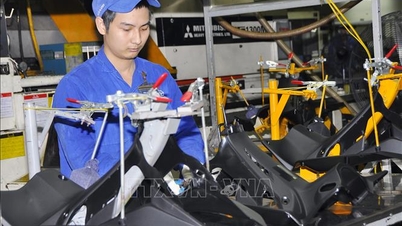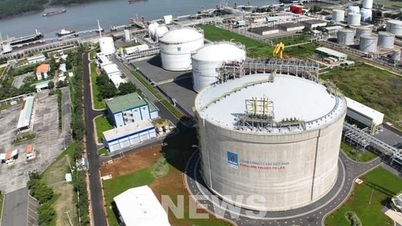
Growth drivers
According to Dr. Nguyen Tu Anh, Director of Policy Research, VinUni University, to achieve the target of economic growth of 10% or more each year, the credit scale of the economy must double in the next 5 years. Specifically, he calculated that if real GDP growth reaches 10%, plus about 3% inflation, then nominal growth will be about 13%. To meet this level, credit growth needs to reach at least 15% per year, about 2 percentage points higher than the nominal GDP growth rate.
That figure clearly shows that the banking system will still be the main capital channel, playing a key role in "pumping blood" into the economy. "Clearly, the role of the banking system in the economy is extremely important," Dr. Nguyen Tu Anh emphasized.
According to this expert, Vietnam is still a “bank-based” economy - relying mainly on banks to provide capital. This model, following the trend of East Asian countries, will likely be maintained for at least the next 15 years. Even if the capital market (stock market, corporate bonds...) develops, banks still have the advantage in providing long-term capital and risk management for the economy.
This stems from the nature of the financial industry. While the capital market requires investors to self-assess and manage risks - a difficult task in an institutional and legal framework that is still being perfected - banks are specialized organizations in collecting, processing information and managing credit risks. Along with the development of digital technology , banks are increasingly able to access big data, optimize costs and expand access to capital to more subjects. Therefore, banks are not only an effective capital channel but also a risk management channel for the economy.
Sharing the same view on the central role of banks, Mr. Quan Trong Thanh, Director of Analysis Department of Maybank Securities Vietnam, said that the room for corporate credit in Vietnam is still very large. Currently, Vietnam's credit/GDP ratio is about 134%; of which, corporate lending accounts for less than 80% of GDP, a fairly healthy level compared to similar economies.
According to Mr. Quan Trong Thanh, the period 2013-2022 witnessed the boom of retail lending, especially for personal consumption, home buying, car buying... However, after 2022, when the macro context fluctuated and personal loan demand slowed down, credit capital flow was shifting strongly to the business sector. From 2024 to now, business lending is becoming the main driver of credit growth and Mr. Thanh believes that this is the right direction.
The structure of social investment also reflects this trend. Citing statistics, Mr. Thanh said that in the period of 2020-2024, total investment capital reached about 682 billion USD; of which the manufacturing sector accounted for the largest proportion. Although the FDI sector still holds the leading share in the manufacturing investment sector - mainly borrowing from international banks - about 44% of the remaining investment capital comes from domestic banks. Notably, three state-owned commercial banks (VietinBank, Vietcombank, BIDV ) account for up to 60% of the market share, narrowing the space for joint-stock banks, forcing them to promote the retail sector. However, in the context of the economy entering a period of strong growth, corporate credit, especially for private enterprises, will be a reasonable expansion direction.
Open direction from infrastructure and energy
In the short term, Mr. Quan Trong Thanh believes that two areas that could become new drivers for bank capital flows are infrastructure and energy. According to the Ministry of Finance's calculations, to achieve the GDP growth target of 10%/year, Vietnam needs a total investment capital of about 1,400 billion USD in the next 5 years, equivalent to 280 billion USD per year. Of which, FDI capital only accounts for about 24-30 billion USD, meaning that more than 250 billion USD per year must come from the domestic sector, including the Government and private enterprises.
The government is now strongly encouraging the private sector to participate in infrastructure and energy investment. “This pie is expanding and the level of participation of private enterprises is also increasing,” said Mr. Thanh. When private enterprises participate, banks are also willing to accompany, as long as the enterprises demonstrate their capacity to implement the project. This is an opportunity for banks and the private sector to create an effective “capital circulation” for the economy.
From a general perspective, both experts assessed that banks are still the main capital channel for Vietnam in the medium and long term. However, that does not mean that the capital market is neglected. On the contrary, there needs to be a parallel development strategy to reduce the burden on the banking system, especially in the context of strong capital demand for production, infrastructure and energy.
Completing the legal framework, improving corporate governance capacity, information transparency and promoting investor confidence will be prerequisites for the capital market to become an "extended arm" of the banking system.
Developing capital channels for the Vietnamese economy in the new period requires harmony between the central role of banks and the rise of the capital market. Dr. Nguyen Tu Anh affirmed that banks will remain the "backbone" of Vietnam's economic capital flow for at least the next 15 years, while Mr. Quan Trong Thanh showed that the space for corporate credit, especially in the fields of production, infrastructure and energy, is still wide open.
When capital channels develop in harmony, Vietnam can completely achieve the target of 10% annual growth in a sustainable and balanced manner, building a safe, flexible financial system and being ready for a new development stage.
Source: https://baotintuc.vn/kinh-te/don-bay-von-cho-tang-truong-20251116085922996.htm





![[Photo] Prime Minister Pham Minh Chinh meets with representatives of outstanding teachers](https://vphoto.vietnam.vn/thumb/1200x675/vietnam/resource/IMAGE/2025/11/15/1763215934276_dsc-0578-jpg.webp)
![[Photo] General Secretary To Lam receives Vice President of Luxshare-ICT Group (China)](https://vphoto.vietnam.vn/thumb/1200x675/vietnam/resource/IMAGE/2025/11/15/1763211137119_a1-bnd-7809-8939-jpg.webp)







































































































Comment (0)